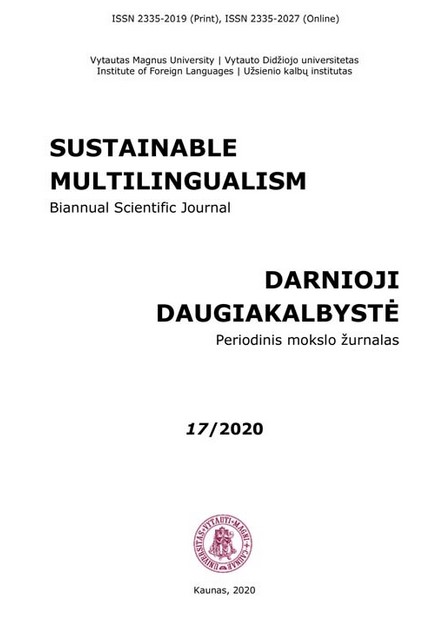MOKOMASIS LIETUVIŲ KALBOS TEKSTYNAS: NAUJAS IŠTEKLIUS BESIMOKANTIESIEMS LIETUVIŲ KALBOS
PEDAGOGIC CORPUS OF LITHUANIAN: A NEW RESOURCE FOR LEARNING AND TEACHING LITHUANIAN AS A FOREIGN LANGUAGE
Author(s): Jolanta Kovalevskaitė, Erika RimkutėSubject(s): Foreign languages learning, Language acquisition, Baltic Languages
Published by: Vytauto Didžiojo Universitetas
Keywords: Pedagogic corpus; Teaching Lithuanian as a foreign language; Common European Framework of Reference for Languages; Written language; Spoken language; Automatic text classification;
Summary/Abstract: The paper aims to present the first pedagogic corpus of Lithuanian i.e. monolingual specialized corpus, prepared for learning and teaching Lithuanian in a foreign language classroom. The corpus has been collected as a result of the project “Lithuanian Academic Scheme for International Cooperation in Baltic Studies”. It is motivated by the need to have a more appropriate resource which could be representative, authentic and relevant enough concerning the process of learning and teaching Lithuanian as it is known that language represented in other existing corpora of Lithuanian (e.g. Corpus of Contemporary Lithuanian, 140 m tokens) is too complex to use for learning activities. The pedagogic corpus includes authentic Lithuanian texts, selected using such criteria as a learner-relevant communicative function and genre. Spoken language as well as written language are represented in the corpus. The size of the corpus is 669.000 tokens: 111.000 tokens from texts and spoken language for A1–A2 levels, 558.000 tokens from texts and spoken language for B1–B2 levels (according to the CEFR – Common European Framework of Reference for Languages). In this paper, we aim to discuss in detail the written subpart of the corpus (containing 620.000 tokens) which includes levelled texts from coursebooks and unlevelled texts from other sources. The level-appropriate labels were assigned automatically to the texts from other sources and this text classification procedure is presented in the paper. The texts from coursebooks and other sources could be classified into 29 text types (dialogs, narratives, information, etc.) and 4 groups according to the communicative aims: informational texts, educational texts, advertising and fiction. Informational texts comprise the biggest part of the corpus; three mostly represented text types differ in coursebook texts and other sources: the most common coursebook texts are informational, narratives, and dialogs (appr. 78% of all coursebook texts). Texts from other sources are represented with richer diversity – appr. 73% of all texts from this subpart can be classified into 5 text types: subtitles, informational texts, educational texts, fiction, and advisory texts. The future work making pedagogic corpus available for learners and its possible application are presented in the closing remarks.
Journal: Darnioji daugiakalbystė
- Issue Year: 2020
- Issue No: 17
- Page Range: 197-230
- Page Count: 34
- Language: Lithuanian

